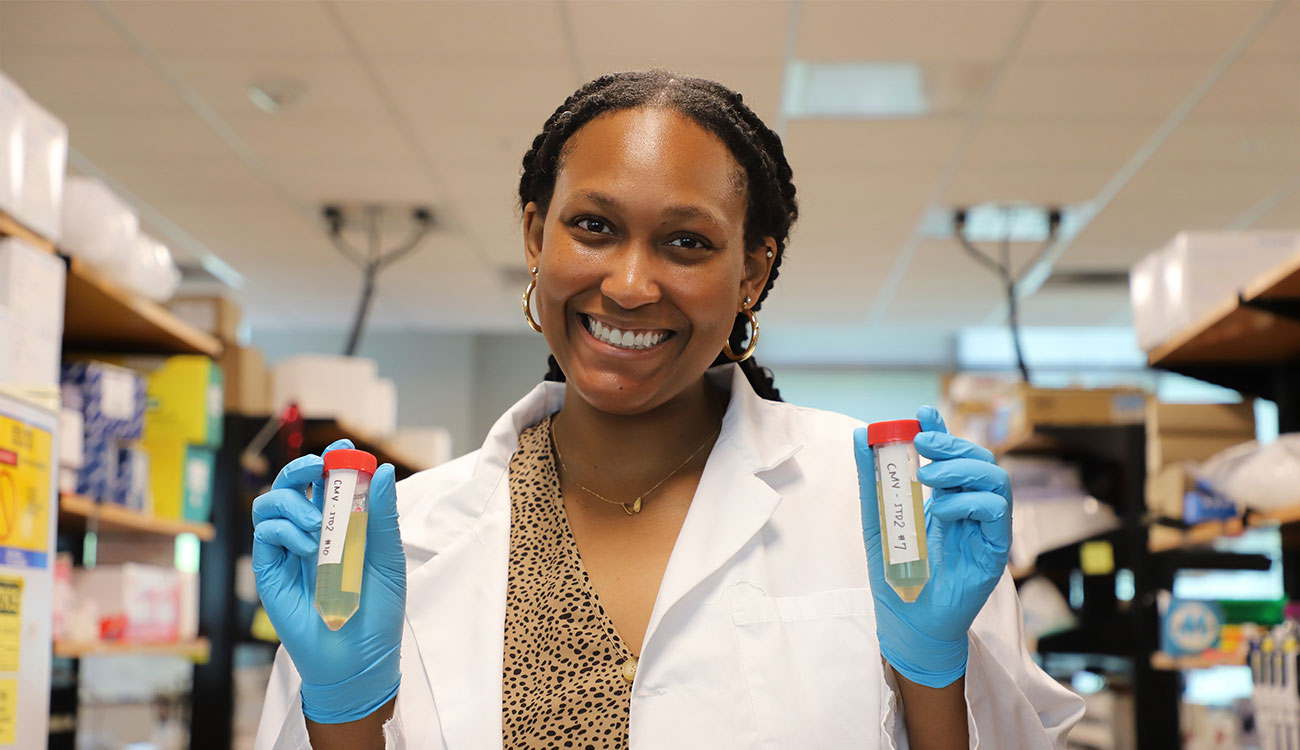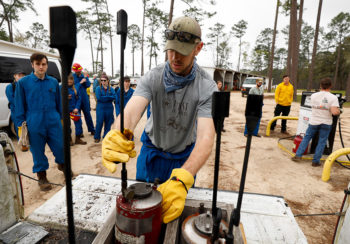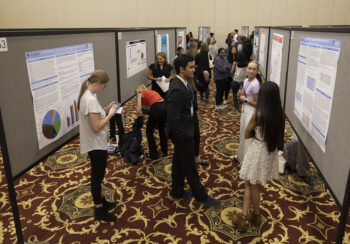Autumn Hampton’s interests run the gamut of academic curiosity. A double-major undergraduate focusing on biochemistry, molecular biology and sociology, she has performed research on identification of the origin of pediatric glioblastomas, an especially aggressive form of brain cancer.
Kade Garrard, a senior majoring in biology, has also done research as an undergrad, examining the relationship between RNA foci and the neurodegenerative disorder Amyotrophic Lateral Sclerosis (ALS).
These are complex research challenges—more complex than one might expect a student just a few years out of high school to explore. And yet, nearly 500 University of Georgia students participated at the Center for Undergraduate Research Opportunities’ (CURO) spring symposium earlier this year, presenting research on challenges like those pursued by Hampton and Garrard.
“A lot of students don’t realize this is here at UGA,” said Andrea Silletti, CURO’s program coordinator and one of UGA’s chief cheerleaders for undergraduate research. “That’s one of the main goals of our office: to make students aware that there are research opportunities, and not just in the STEM fields. It doesn’t have to look like research in a lab with a lab coat and goggles. There’s all kinds of research, and they can be involved right now.”
CURO began in 1997 as a special opportunity for honors students. They identified a particular area of interest, made faculty connections with CURO’s help and began a course that prepared them for research after graduation. The first symposium event, held in 1999, included just 12 students. In 2010, CURO opened its doors to all interested undergraduates and participation exploded.
From identifying important areas of study to learning how to conduct research, exploring new frontiers in education and gaining important experience in public speaking, Silletti said the benefits are well worth the commitment.
The students feel the same way.
Learning in the lab
The life cycle of undergraduate research begins with the students, who identify a particular area of interest and connect with faculty who work in that domain. Silletti encouraged students to make those connections early, so they have time for any related training the faculty may require.
While students take the first step, CURO is there to guide them in turning research experience into course credit, to help in scholarship support and to share presentation opportunities for students.
Each year culminates with the spring CURO Symposium, where students can present their findings in an engaging, low-stress environment.
The 2023 symposium was held April 3-4 at the Classic Center, and it showcased CURO’s ability to bring together interdisciplinary work from across campus. It featured research in life sciences; public and international affairs; arts, humanities and media; physical and environmental sciences; social sciences; business, technology, engineering and math.
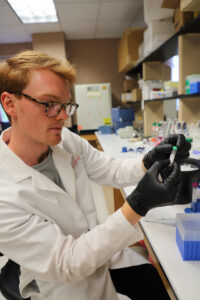
It was this cross-disciplinary nature that drew in Hampton, a sophomore whose interests are also far-reaching.
“Seeing people doing research in business, in international affairs—research that’s so different from my own—I thought was super cool,” she said. “It was exciting that I got to present my own research to people who might be unfamiliar with it, and my family got to come and see what I’ve been researching as well.”
Hampton’s faculty adviser, Assistant Professor Kosuke Funato, could see first-hand the academic gap being filled for students.
“When I was an undergrad, I saw a wide gap between what was taught in classes and what was happening in laboratories,” he said. “That’s mostly still the case. CURO provides a wonderful opportunity for undergrads to learn the cutting-edge technologies utilized in labs and tackle new questions that nobody knows the answer to.”
For Garrard, the entire symposium experience was enlivening—making connections and building relationships, forming potential partnerships that may flourish in projects down the road.
“I love walking around and seeing all the posters at the symposium,” he said. “Every year, there are more and more faces, and that’s an exciting thing to see. CURO really is a great way to connect to the research community at UGA and beyond.”
Silleti noted two of the symposium’s most important benefits: confidence and impact.
“It’s a boost of confidence,” she said. “Your research isn’t as impactful if no one knows what you did. We’re not expecting you to solve the world’s problems as an undergrad—though some will, because we have amazing students—but everything you do can have some impact if others know about it.
“That’s what this opportunity is all about.”
“When I was an undergrad, I saw a wide gap between what was taught in classes and what was happening in laboratories. That’s mostly still the case. CURO provides a wonderful opportunity for undergrads to learn the cutting-edge technologies utilized in labs and tackle new questions that nobody knows the answer to.”
– Kosuke Funato, Assistant Professor & Center for Molecular Medicine member
Photo courtesy of Memorial Sloan-Kettering Cancer Center
Immersive experiences for young researchers
CURO also offers more than just the symposium. Every summer, it awards fellowships to students pursuing research, providing them with financial support and the opportunity to participate in workshops, lectures and other events.

The CURO Summer Research Fellowship allowed Benjamin Frick to investigate in a more personal environment. A senior majoring in ecology and minoring in studio art, Frick has had the opportunity to research several topics throughout his multi-year CURO experience. It was the one-on-one opportunity provided by the fellowship that has, perhaps, most prepared him for a future in the field.
“The support and guidance that I got through the CURO Summer Research Fellowship definitely helped me prepare to act as an independent researcher,” said Frick, whose latest focus is understanding how the purple pitcher plant can be used as an indicator for climate change-based shifts in the genus Sarracenia. “It really does feel nice to be recognized and to get to work in a more intimate environment.”
Garrard also got the chance to work as a CURO Summer Research Fellow, describing his experience as a “few good months of intensive, full-time research.”
“Being awarded the fellowship can really push your research to a higher, more professional level,” he said. “It’s much easier for me to attend conferences because of the plethora of research experience I picked up.”
There is also the Conference Participation Grant, which helps CURO participants travel across the country to share their work and collaborate with peer researchers. Participating in conferences, the students agreed, is a vital part of the undergraduate learning experience.
The Participation Grant enabled Abigail Gilbert to present her research at Harvard University’s National Collegiate Research Conference in January 2023. A junior studying psychology, Gilbert’s research focuses on the effectiveness of relationship education programs, especially in light of the shift to virtual spaces during COVID-19.
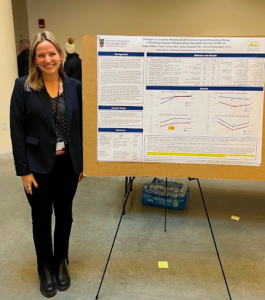
“It was an amazing experience and really would not have been possible without the support of CURO,” Gilbert said. “They sent out a list of conferences to CURO participants, and this one intrigued me. You never really know where CURO will take you.”
Christina James had the chance to attend a conference in Eau Claire, Wisconsin. A junior studying biology and psychology with an emphasis in neuroscience, James was excited by the opportunity to share her work on organoids and collaborate with fellow researchers.
“My research was borne out of something very interdisciplinary,” James said, “and so I was thrilled to attend this interdisciplinary conference and see researchers’ work across many different fields.”
No experience required—benefits for a lifetime
It’s not just the students who benefit from CURO. Ted Futris, professor and director of the Couple and Relationship Enrichment (CARE) Lab, said that working with students like Gilbert have been a boon to his lab’s success, as well.
“Students play a vital role in helping us recruit participants, collect and enter data, and prepare reports and presentations for our funders and other stakeholders,” he said. “It’s exciting to see them develop the competencies and confidence needed to be producers and consumers of scholarly research.”
CURO-participating faculty members also want students to know that expertise is not a prerequisite. They’re looking for interest, flexibility and motivation.
“Foundational knowledge mostly only determines the type of project a student may contribute to,” said Brandon Rotavera, an associate professor in the Department of Chemistry. “Research is an instrument for teaching complex topics beyond the classroom, and it requires patience and flexibility with time.”
Rotavera has welcomed multiple CURO students into his lab, including Joshua DeJongh, now a master’s student in mechanical engineering. He said the experience made a difference for his graduate career.
“Participating in CURO really helped my research move forward,” he said, “especially with the things that often aren’t taught in the classroom, like technical writing.”
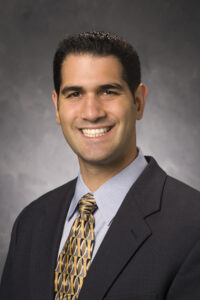
In his lab, Futris said he looks for team players.
“I have a large team of graduate and undergraduate students, and the success of our lab projects relies on everyone working together,” Futris said.
Indeed, Silletti said CURO is more than just something students do for course credit—it’s a way to build a broader UGA undergraduate research community.
“It’s a place students can come to interact with other students and have a place at UGA where they belong and exchange ideas,” she said. “They feel like researchers, because they are. That’s what we want this program to facilitate.”At the end of the day, no matter how students engage with the program, CURO provides them with something that will prove useful far beyond their college years.
Samuel Hartness, currently pursuing his doctorate in engineering, said undergraduate research at UGA helped him decide whether he’d move on to a graduate degree. He has now earned both a bachelor’s in biochemical engineering and a master’s in mechanical engineering, both at UGA.
“CURO helped me get my feet wet with research,” he said. “It helped me see what my day-to-day was going to be like as a graduate student. For undergrads looking to get involved with CURO, it’s an all-around good decision.”
VIDEO: Learn more about how CURO helps foster research opportunities for undergraduates.



